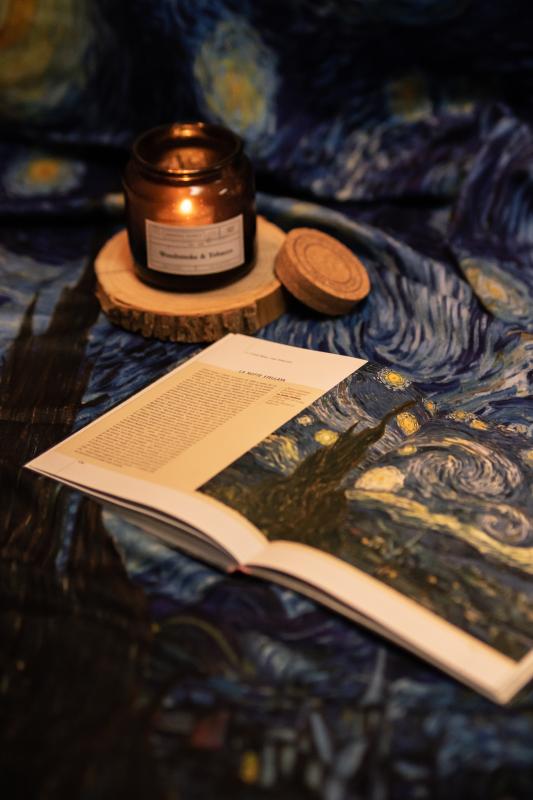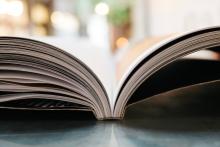Explore Ekphrastic Poems: A Reading List

Photo of Vincent van Gogh's painting The Starry Night by Melissa Andreotti on Unsplash
“The old unseen serpent swallows up the stars. / Oh starry starry night!” These lines are from The Starry Night by Anne Sexton, an ekphrastic poem that vividly portrays the famous painting by Vincent van Gogh—The Starry Night.
Derived from the Greek word “ekphrasis,” meaning description or interpretation, ekphrastic poems are a unique form of artistic expression, in which the writer typically uses verbal descriptions or written responses to a work of art, such as a painting, sculpture, or photograph. Through the artful interplay of words and imagery, ekphrastic poems offer a fresh perspective and expand upon original artwork, bridging the gap between visual and literary realms.
Here is a reading list of ekphrastic poems that we gathered to shine a light on art inspiring art.
Dinosaurs in the Hood by Danez Smith
“Let’s make a movie called Dinosaurs in the Hood. / Jurassic Park meets Friday meets The Pursuit of Happyness.”
Smith's poem delves into the description of a movie, inspired by the iconic film Jurassic Park, which shows communities comprised of "children of slaves & immigrants & addicts & exiles." Within the poem, a clash unfolds as the neighborhood's aesthetic intertwines with the presence of pterodactyls and raptors. However, the poem's impact lies in its resolute plea for the movie to transcend ethnic stereotypes. It asserts that the film "can't be a black movie," "can't serve as a metaphor/ for black people & extinction," and "can't revolve around race." By challenging these preconceived notions, the poem navigates the complexities of representation and highlights the importance of avoiding reductive categorizations.
The Starry Night by Anne Sexton
“Even the moon bulges in its orange irons / to push children, like a god, from its eye.”
In this poem, Anne Sexton uses figurative language to describe the stars and the sky and provides insight into the turbulent inner thoughts of Vincent van Gogh. Sexton also intertwines excerpts from Van Gogh's personal letters, wherein he expresses his inclination to paint the stars when sadness befalls him.
Aubade with Burning City by Ocean Vuong
“The song moving through the city like a widow. / A white ... A white ...I’m dreaming of a curtain of snow”
In this poem, Ocean Vuong weaves the lyrics of Irving Berlin's "White Christmas" into a scene depicting Vietnamese refugees. Through the artful technique of juxtaposition, the convergence of the song and the refugee narrative generate a disconcerting and haunting atmosphere. This literary device serves to reveal the unexpected parallels and similarities hidden within the apparent stark contrast between the two elements. The poem takes on the form of an aubade, traditionally praising the morning. It commences against the backdrop of daybreak, adding further layers of meaning and setting the tone for the complex journey that follows.
Ode on a Grecian Urn by John Keats
“When old age shall this generation waste, / Thou shalt remain, in midst of other woe”
Penned amidst the throes of tuberculosis, poet John Keats infuses his emotions of mortality and weakness. Structured across five stanzas, he exalts an ancient urn deemed eternally enduring, transcending the boundaries of time and conveying narratives to generations yet to come.
Musée des Beaux Arts by W.H. Auden
“In Brueghel's Icarus, for instance: how everything turns away / Quite leisurely from the disaster; the ploughman may”
Poet W.H. Auden leaves room for the reader's interpretation in Musée des Beaux Arts. The poem centers around Pieter Brueghel's painting The Landscape with the Fall of Icarus, which portrays a man plummeting from the sky while a ship glides past—seemingly indifferent to the tragic event unfolding in the water below. The poem serves as a commentary on humanity's position in the world and the ephemeral nature of existence.
The Tall Figures of Giacometti by May Swenson
“The products of excruciating purges / we are squeezed out thin hard and dry.”
May Swenson's poem, The Tall Figures of Giacometti, serves as a direct response to the creations of Swiss sculptor Alberto Giacometti. Within the stanzas, the sculptures manifest as statuesque, petrified saints frozen in time, offering the reader a distinctive perspective on some of the most renowned sculptural works in history. The poem delves into the intricacies of each sculpted feature, unveiling the influence they hold over the narrator.





